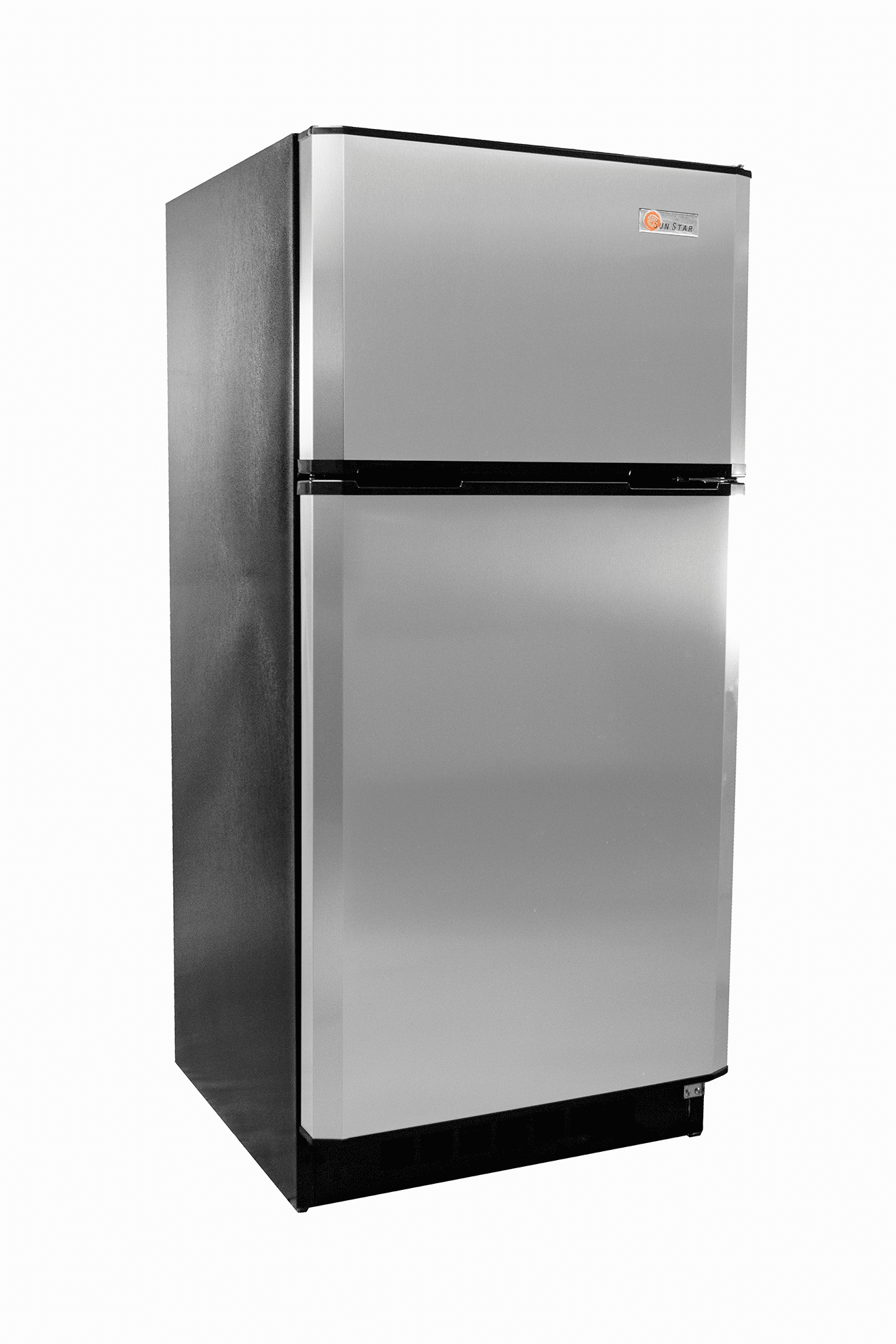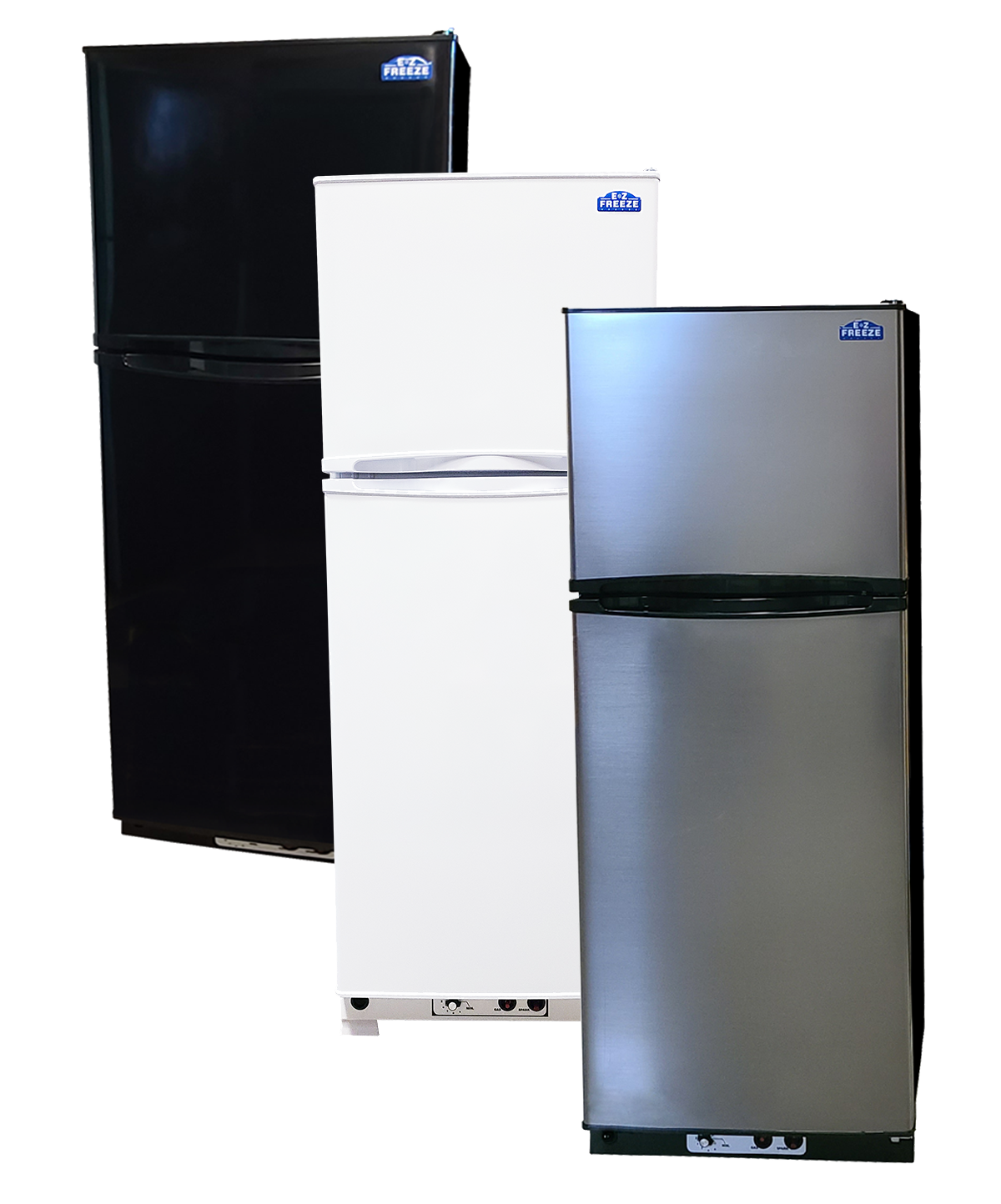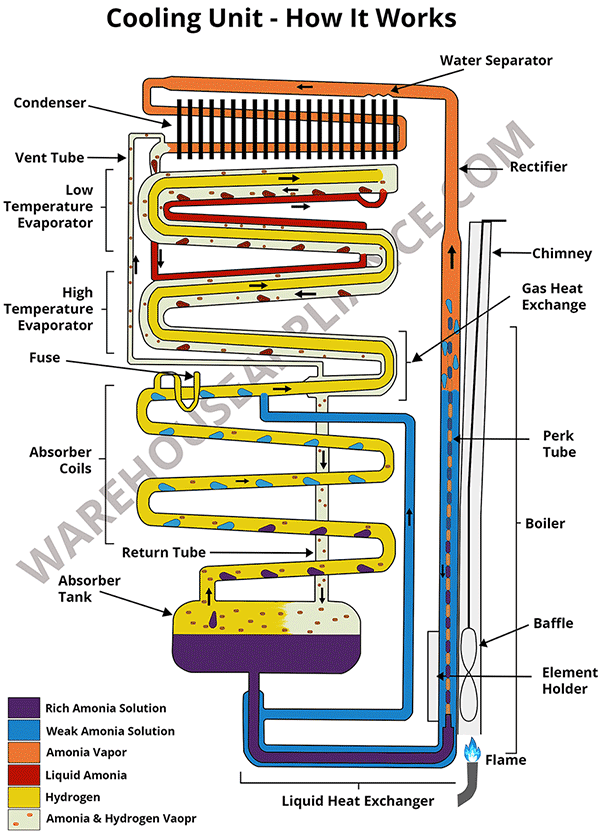Warehouse Appliance is a leading provider and expert in propane refrigeration, including in providing details when asked, “how does a propane refrigerator work?” The process is incredibly efficient and interesting. Best of all, it provides homes and businesses with a dependable solution for cooling and maintaining perishable goods, especially when off the grid.
How Do Propane Refrigerators Work? The Origins:
When looking into how a propane refrigerator functions we go back to 1820 when English scientist Michael Faraday used liquefied ammonia to cause cooling. And our modern-day civilization can credit this early start to effective cooling – as it sets the foundation for today’s refrigerators. Absorption ammonia refrigerators or gas refrigerators still function on the same foundational basis as what Micheal Faraday had started with all those years ago. The mixture that these cooling systems use is a blend of anhydrous ammonia, distilled water, and hydrogen vapor.
Using LP Gas to Power a Gas Fridge
Liquefied Petroleum Gas, also known as propane, is a byproduct of natural gas processing and a byproduct of refining petroleum, making it an inexpensive commercially available fuel source. This vapor is compressed into a liquid form for transportation and storage. Propane gas is a cleaner burning gas than gasoline but slightly less clean burning than natural gas. Propane gas is odorless in raw form but a fragrance is added to help in leak detection. Most describe the fragrance as a rotten egg smell.
See the image to the right to locate the propane refrigerator parts.
This gas type is well suited for off grid living because it is very portable and perfect for propane appliances. It is often transported in small steel cylinders, or it can be delivered by truck to a permanent on site tank. This makes it a great solution for energy storage in nearly any environment, which also makes it great for an off grid refrigerator.
Using propane gas to power a refrigerator seems out of the norm, but in fact, this application has been used since the early 1900s. One of the more popular brands in the 1940s was the Servel LP gas refrigerator. Many are still in operation today, being used as off grid refrigerators. These old units have been recalled and many are taken out of service and replaced with new, more modern and more efficient models. Read here for more about the recall.
The Efficiency of Propane-Powered Refrigerators
The size of your propane refrigerator, the number of people depending on it, and the environment it is being used in will determine how much propane gas it will use. We usually see an average of 2 gallons per week – sometimes as low as one gallon per week or as high as 3 gallons per week in the extreme. The flame for a propane fridge only burns 1750 BTU on high flame and 800 BTU on low flame. A propane refrigerator will operate most of the time on low flame. The actual physical flame size is about the size equal to a cigarette lighter. The EZ Freeze brand of refrigerators from Warehouse Appliance is tested to put off less than 50 parts per million of carbon dioxide, which is a safe level for home interiors.
How Does a Propane Fridge Work When Cooling?
For cooling in a propane refrigerator, the ammonia and water in the cooling unit is heated by a propane flame, which is exactly why a propane refrigerator gets its name. The heat from the propane flame then causes the ammonia and the water to vaporize into steam, traveling through the perk tube. From there, the process that this steam follows is to then percolate or perk. This same perking process is very similar to the process that a coffee percolator adheres to. At this stage, this is where the inner tube, also known as the perk tube, in the propane refrigerator boiler emits steam as water bubbles, causing them to move upward.
Between these two mixed components – since the ammonia is lighter than the water – the ammonia will turn into steam earlier than the water will. This then allows for the ammonia steam to be pushed up into a condenser by the hydrogen pressure that is generated. As the heat is dissipating, the water will fall down into the outer tube. From there, it is then pushed into the absorber tubes, which then returns to the mixing tank, also known as the absorber tank.
As the ammonia steam is moving upward through the rectifier and into the condenser tubes, it then turns into a rich ammonia liquid once more. Here, this rich ammonia liquid is then pushed into the top of the evaporator tubing. After it is in the evaporator, it then meets the hydrogen gas moving up through the inner tube inside the evaporator. From here, this hydrogen gas absorbs the rich ammonia. As the ammonia meets this hydrogen gas here in the evaporator, it then creates a chemical reaction. This chemical reaction then evaporates the ammonia, making it extremely cold at that point. This is what absorbs the heat, removing it from the refrigerator box.

In the meantime, you will find that the water is then being pushed backwards to the absorber coils. At this point, this is where the water drops downward to the absorber tank. While this is happening, the hydrogen gas passes upward through the absorber coils and “catches” any ammonia left in the weak water that is falling downward and carries it up to the top of the evaporation system. From there, it then drops it into the outer tube of the evaporator. It then flows downward in a mist form, causing it to become extremely cold. As it falls down, the rich ammonia returns to the absorber tank, also called the mixing tank. In the absorber tank, the rich ammonia mixes with the weak water, which allows it to continue with its cycle all over again.
How Does a Propane Refrigerator Work to Maintain Consistent Cooling?
Constantly looping through the above processes allows a propane refrigerator to generate a continuous cooling effect. With the ammonia serving as the coolant along with the water, ammonia and propane provide a continuous cooling effect.
In summary, we learned about the following:
- Ammonia will cycle through from gas to liquid, and this process causes a cooling effect
- Hydrogen vapor or hydrogen gas generated by the boiling water
- Distilled Water – more dense and heavier than ammonia, allowing for the ammonia to boil and steam first
- Propane – used as the fuel source to generate enough heat to start the cycle and boil the water and liquid ammonia
- Generator – creating the ammonia gas
- Separator – separates the ammonia from the water
- Condenser – this is where the hot ammonia gas cools and then is condensed again to create the liquid ammonia
- Evaporator – converts the liquid ammonia to a gas, causing the cooling effect
- Absorber tank, also known as the mixing tank where the water absorbs the ammonia gas
An ammonia absorption cooling system is a unique design. It is designed specifically so that it can operate independently by using either a propane, natural gas, or butane burner in order to heat the ammonia solution, creating an ammonia refrigerator. Earlier on, there were also many cooling units that used a kerosene burner to heat a cooling solution. This type of kerosene fueled refrigerator is still available on the market, yet its availability is in a limited capacity.

Contact Us Today for Further Details on How Propane Fridges Operate
At Warehouse Appliance, we understand how complicated it can be to understand how a propane refrigerator works. Our modern-day propane refrigerator technology would not be possible without the discoveries of Michael Faraday and those early refrigeration mechanics. Our propane refrigerators of today are much improved in efficiency, capacity, fuel efficiency, and functionality, but we owe our thanks to these early inventors for the beautiful propane refrigerators of the modern day. Our propane refrigerators provide options for hunters, homesteaders, and more by allowing effective alternatives for off grid refrigeration and food storage.
To learn more or get a recommendation for a propane fridge for your needs, contact our team today!






